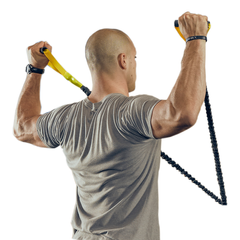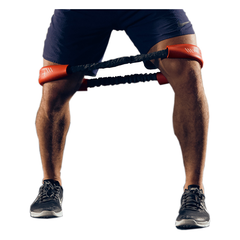Is your warm-up program leaving performance gains on the table?
Be sure you are checking each of these boxes as part of your pre-training program:
 Increase Temperature
Increase Temperature
Research shows that power, flexibility, and force production all increase when the body gets hot. If your warm-up isn’t generating some sweat, then it is an ineffective warm-up.
If you are training in a garage in July, increasing muscle temp won’t be an issue. But for cooler climates, or training in the air conditioning, throw on a sweatshirt to help the process. The best approach is to throw it on while driving to the gym or practice field, and then keep it on as you go through your warm-up.
It’s important to note, that this is not a case of more is better. Becoming overheated is detrimental to performance, especially for longer endurance events. As soon as you start getting sweaty you can begin to shed some layers of your warm-up attire.
 Increase Blood Flow
Increase Blood Flow
To get ready to perform, you need to get blood flowing towards muscle. That means getting the heart pumping faster with more force, and shunting blood away from organs not essential for performance.
Light aerobic activity is all that it takes, but it doesn’t have to be running or biking. Take this opportunity to improve your athleticism with activities like speed ladders, running football routes, shooting hoops, jump rope practice, and other fun movements. These activities will make you a better athlete and aren’t all that boring, so throw on a hoodie and start playing.
 Increase Range of Motion
Increase Range of Motion
Many injuries are provoked by short and stiff muscles. The good news is muscle pliability can be improved quickly with the correct strategies in the warm-up.
However, this is not the time for a mega smash session or a full yoga routine, just a quick and aggressive attack of your greatest limiter. This is like the last minute test cram, the majority of the studying (i.e.-mobility work) should have been done prior to that point. So focus on the areas that will hold you back in the upcoming workout.
Foam rolling can improve range of motion without affecting performance like static stretching does (ref), but it’s a sedentary approach that contradicts the goal of getting moving for a practice or training session. Therefore, dynamic mobility work is preferred for the pre-workout routine.
(One exception is foam rolling the thoracic spine for overhead lifting, it’s one of the best approaches for improving thoracic extension.)
 Muscle Activation
Muscle Activation
Doing a simple series of exercises gets muscles firing that have been relatively inactive as part of normal daily living.
One key benefit is immediate improvements in range of motion. Often joints are stiff from previous workouts or hours of inactivity. Getting muscles contracting at the end ranges can quickly improve range of motion.
Additionally, muscle activation helps improve movement quality by training the body to incorporate key stabilizers. Immediate differences are often felt, but even more important are the long term gains coming from a muscle activation routine. Over time the daily practice of creating better stability and coordination will build movement proficiency for better lifts, as well as fight injury.
It shouldn’t be a 30 minute routine either, just run through 8-10 reps, isolating key stabilizers in the body.
 Prime the Nervous System
Prime the Nervous System
The nervous system runs on 2 modes—”rest and digest” and “flight or fight”. A good warm-up stimulates the fight or flight system, which tells the body it’s time to go, not chill out.
First off, no strategy will work here if you’re overtrained or lacking sleep. You will not be able to put forth your best effort if your body is not physically up to the task. If you’re showing up rested, the nervous system should kick into action as you ramp up into your training.
Choose to go au natural if you like, but caffeine can help get the nervous system going. It’s one of the few supplements with solid evidence showing that it improves performance (ref).
Mental imagery can also stimulate the fight or flight system (ref, ref), so instead of zoning out, think through the training at hand. Try to visualize success and the great things you will accomplish today.
Otherwise, turn the music loud, it’s time to get pumped-up!
 Prime Metabolic Pathways
Prime Metabolic Pathways
Muscles are powered by a substance called ATP. The body stores fuel in muscle, blood, and liver to create ATP when needed. Getting the many fuel transport systems going early will yield better performance later on.
In order to facilitate this, there should be some brief periods of breathlessness. But too often warm-ups don’t touch a level of intensity more than light aerobic work.
Try adding some short sprints, burpees, squats, or anything else that makes the muscles work a bit. No need to overdo it, just 3 or 4 hard intervals of 30 seconds should better prepare your body for the next step of training.
This brief bout of intense work also help fire up the nervous system for the harder work to come.
Death to Crappy Workouts
There are times that going to the gym is a chore, and sometimes it seems like there isn’t enough time in the day to get it done.
It’s ok to feel that way, but don’t let it stop you from getting it done.
Even if you are lacking in motivation, have the discipline to show up and at least run through a solid warm-up. This is often the dose of go-juice needed to get excited about training that day. Worst case scenario, that is all you do that day, which is exponentially better than completing nothing.
Write it off as an active recovery day and show up the next day ready to perform.
Regardless, be sure you are checking each box as part of priming your body to perform.
 Shoulder Packages
Shoulder Packages
 Hip & Core Package
Hip & Core Package
 NEW - Crossover TORQ
NEW - Crossover TORQ
 Bundles
Bundles
 Accessories
Accessories

























